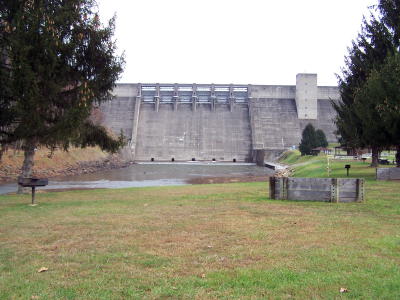
Sutton Dam could be site of hydro-electric generator
(Hur Herald Photo)
COMMENT by Bob Weaver
A search for cleaner electricity has developers seeking permits for
hydroelectric turbines at West Virginia dams.
One project is a proposed generator at Sutton Dam.
Wind and water technology is threatening the giant coal-burning electric plants in WV that supply electric to the eastern corridor.
Brookfield Renewable Power of MA is completing a field of studies required for issuing a permit for the generator.
The use of clean and renewable energy is on the upswing across the US.
The descending of thick, toxic smog in the greater Kanawha Valley several times since 2008, has further questioned increasing the capacity of Putnam County's John Amos coal-fired plant.
The Mid-Ohio Valley and the northern panhandle areas are so use to breathing bad air, they have enhanced their denial skills.
Most West Virginians want to believe they breathe clean mountain air and drink clean mountain water, while nearly all national studies indicate state residents in a toxic melting pot.
That plant and others proposed to be built in WV, would send coal-generated electric on giant transmission lines across several counties (PATH Project) - that project costing several billion dollars, some of which would be paid by West Virginia users.
The mega-power PATH facilities and high-tower projects, since their initial proposal, are facing some major hurdles: a decrease in power usage in the corridor, fossil-fuel pollution and the current recession.
The continued filling of hundreds of miles of WV streams by mountaintop removal, with studies of water quality in those streams showed the abolition of fish and aquatic life.
Proponents for change think locating cleaner power plants closer to metro areas needing electricity is much more practical than hundreds of miles of high-tower lines.
The hydro-generator at Sutton is one small project that makes sense, retrofitting a flood control dam with turbines.
David Sinclair, president of Advanced Hydro Solutions, is focusing on four potential hydro-power projects in Pennsylvania and West Virginia.
Tygart Dam near Grafton was even built with hydro-power in mind. The Corps of Engineers' designed it in the 1930s with twin 15-foot-diameter tunnels. The tunnels have been capped ever since.
Sinclair's company is studying whether it's economical to pull the plugs, install turbines and start generating electricity.
The West Virginia Division of Energy says Tygart and other projects hold the promise of increasing the state's 264-megawatt hydro-power capacity almost 50 percent.
The proposals for wind and water generator are targets of the coal industry, saying they cannot economical provide energy.
Sutton Dam on the Elk River was constructed in 1957 for the purposes of flood control. It has been issued a preliminary permit to explore its' development for electric generation.
Generators from about 8 to 20 megawatts are being studied for the R.D. Bailey Dam on the Guyandotte River, the Sutton Dam on the Elk River and the Jennings Randolph Dam on the North Branch of the Potomac.
Every minute of every day, water that could generate electricity flows through West Virginia dams. It is one of the state's underdeveloped resources.
"These dams are typically opportunities waiting to happen," said West Virginia Division of Energy Director Jeff Herholdt.
Currently in West Virginia there are 10 operating hydroelectric facilities that support just over 300 megawatts of generating capacity, or about the capacity of a small coal-fired power plant.
Despite the small operations, those plants generated enough clean electricity in 2006 to power 130,000 homes, or about 15 percent of the households in the state.
"Public policy is leaning more and more toward the acquisition of renewable power by consumers," said Brookfield Power executive Daniel Whyte.
Brookfield operates the Hawks Nest hydroelectric facility in Fayette County.
"We are on the verge of an energy revolution," said Christopher Flavin, president of Worldwatch and author of the report, "Low-Carbon Energy: A Roadmap."
Worldwatch, a nonprofit that follows environmental and poverty issues, says that reducing dependence on fossil fuels will not only "strike a defiant blow to the climate crisis," but also act "as an agent of recovery for an ailing global economy."
The 49-page report disputes arguments from coal industry advocates who say the world's energy future must be based mostly on finding ways to capture greenhouse emissions from coal-fired plants and pump those emissions underground.
"While these technologies are advancing, together with advances in modeling and monitoring of geological sites, full-scale commercial [carbon capture and storage] systems are still a long way off," says the Worldwatch report.
"A vast physical infrastructure for 'clean-coal' will be needed to capture, move and store the emissions from even a fraction of today's fossil fuels combustion," the report said.
| 


